Today we are talking about a tree that seems familiar but is nevertheless foreign and rare in Laos. It seems familiar because it belongs to the large group of Leguminosae and is sometimes confused with the flamboyant; it is rare because it is an American tree that has traveled little, and yet we found two feet of it at the bottom of Wat Sok Palouang and another outside the enclosure wall of Wat Simuang, on the west side. This tree has no name in Lao and the people we interviewed either confessed their ignorance or called it tone fang (Flamboyant).
In most languages, scientific and vernacular, it is the shape of its pods that is decisive: they resemble a more or less large ear. Latin says cyclocarpum, that is to say “fruit in the shape of a cycle”; English evokes an elephant ear, Elephant Ear Tree, or devil’s ear, Devil’s Ear Tree; in Creole of the French West Indies it is called zorèy milat, “mulatto ear” in reference to the ethnic distinctions that have always been made in these islands. In Costa Rica, where its name comes from an Aztec language, the Guanacaste was declared a national tree in 1959.
Enterolobium cyclocarpum found from southern Brazil to the West Indies is a large tree that can reach 30 m with a powerful trunk and a few large main branches under a dome-shaped foliage, like a saman (sam sa). But the shape of this solitary tree depends much on its environment. Its bark is smooth and reddish, dotted with small characteristic bulges. Its leaves are alternate, bipinnate, from 15 to 40cm long, thin and light; they can, from far, be confused with those of the Flamboyant. Globular inflorescences, composed of about twenty small yellow odorous flowers, appear at the axis of the leaves. Then pods are progressively formed, first green, then brown at maturity, rigid like an old leather, rolled up in irregular circle from 8 to 15 cm, which can make think of ears. They are swollen by the seeds they contain, from 3 to 12, oblong, dark brown, bordered by a lighter line.
The wood of zorèy milat has many uses; light and resistant to water thanks to its resin, it was formerly used by the Amerindians to make their canoe; it is used today in the construction of houses and the manufacture of heavy and durable luxury furniture (“for a lifetime” says the popular saying). The fruit and bark of zorèy milat are rich in saponin and can be used as soap; the bark also contains tannins giving it an application in the leather industry. The hard seeds can be eaten boiled or roasted, but most importantly, they are used to make beautiful necklaces.
If you want to have a foot of this beautiful tree, you can now go and collect a few ripe pods at Wat Sok Palouang or Wat Simuang; you will have to break them by hand because they do not open by themselves. You will have to break them by hand because they do not open by themselves. You will then put them to soak in water for 7 to 8 hours to soften the tegument which is very hard. You can then plant them and they will germinate in 4 or 5 days. Finally, you should know that from the first year the tree reaches more than a meter and that afterwards it will need a lot of space to have a spread out port.
Nous parlons aujourd’hui d’un arbre qui semble familier mais qui pourtant est étranger et rare au Laos. Il semble familier car il appartient au grand groupe des Légumineuses et est parfois confondu avec le flamboyant; il est rare car c’est un arbre américain qui a peu voyagé, et pourtant nous en avons trouvé deux pieds au fond du Vat Sok Palouang et un autre à l’extérieur du mur d’enceinte du Vat Simuang, côté ouest. Cet arbre n’a pas de nom en lao et les personnes interrogées, soit avouaient leur ignorance, soit le nommaient tone fang (Flamboyant).
Dans la plupart des langues, scientifiques et vernaculaires, c’est la forme de ses gousses qui est déterminante: elles ressemblent en effet à une oreille plus ou moins grosse. Le latin dit cyclocarpum, c’est-à-dire « fruit en forme de cycle »; l’anglais évoque une oreille d’éléphant, Elephant Ear Tree, ou de diable, Devil’s Ear Tree; en créole des Antilles françaises on le nomme zorèy milat, «oreille de mulâtre » en référence aux distinctions ethniques qui ont toujours cours dans ces îles. Au Costa Rica, où son nom vient d’une langue aztèque, le Guanacaste a été déclaré arbre national en 1959.
Enterolobium cyclocarpum que l’on trouve du sud du Brésil jusqu’aux Antilles est un arbre de grande taille qui peut atteindre 30 m avec un tronc puissant et quelques grosses branches principales sous un feuillage étalé en dôme, à la façon des saman (sam sa). Cependant, la forme de cet arbre solitaire dépend beaucoup de son environnement. Son écorce est lisse et rougeâtre, parsemée de petits bourrelets caractéristiques. Ses feuilles sont alternes, bipennées, de 15 à 40cm de long, fines et légères; elles peuvent, de loin, être confondues avec celles du Flamboyant. Des inflorescences globuleuses, composées d’une vingtaine de petites fleurs odorantes jaunes pâles, apparaissent à l’axe des feuilles. Ensuite se forment progressivement des gousses, d’abord vertes, puis marrons à maturité, rigides comme un vieux cuir, enroulées en cercle irrégulier de 8 à 15 cm, qui peuvent faire penser à des oreilles. Elles sont renflées par les graines qu’elles contiennent, de 3 à 12, oblongues, marron foncé, bordées d’une ligne plus claire.
Le bois de zorèy milat a de nombreuses utilisations; léger et résistant à l’eau grâce à sa résine, il était utilisé autrefois par les Amérindiens pour faire leur canoë; il sert aujourd’hui dans la construction des maisons et la fabrication de meubles de luxe, lourds et durables (« pour toute une vie » dit le dicton populaire). Le fruit et l’écorce de zorèy milat sont riches en saponine et peuvent être employés comme savon; l’écorce contient également des tanins lui donnant une application dans l’industrie du cuir. Les graines dures peuvent être mangées bouillies ou grillées mais surtout, on en fait de très jolis colliers.
Si vous voulez avoir un pied de ce bel arbre, vous pouvez dès maintenant aller en ramasser quelques gousses mûres au Vat Sok Palouang ou au Vat Simuang; il faudra les casser à la main car elles ne s’ouvrent pas toutes seules. Vous les mettrez ensuite à tremper dans l’eau pendant 7 à 8 heures pour amollir le tégument qui est très dur. Vous pourrez ensuite les planter et elles germeront en 4 ou 5 jours. Sachez enfin que dès la première année l’arbre atteint plus d’un mètre et que par la suite il aura besoin de beaucoup d’espace pour avoir un port étalé.
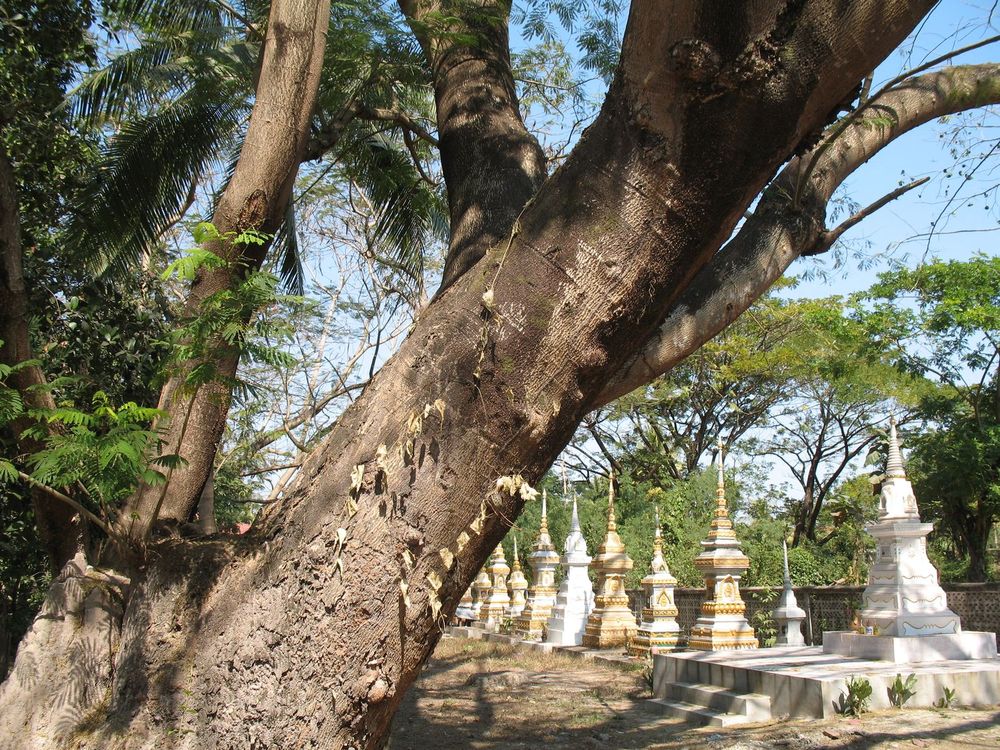
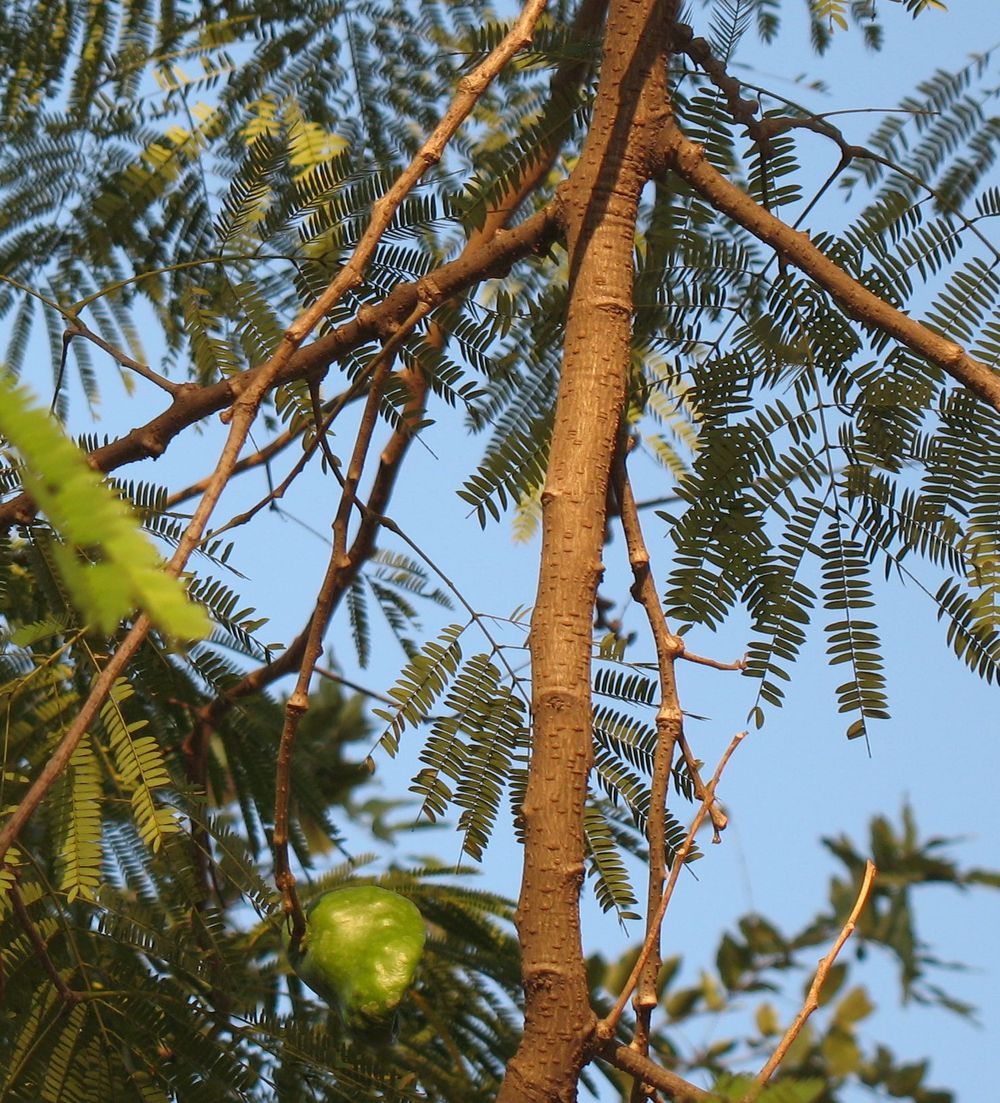
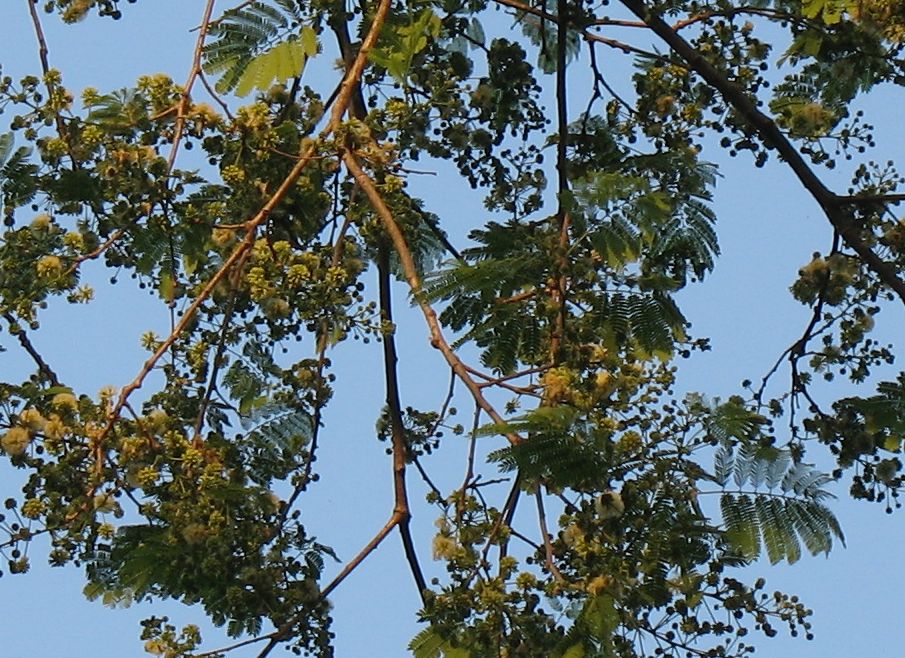
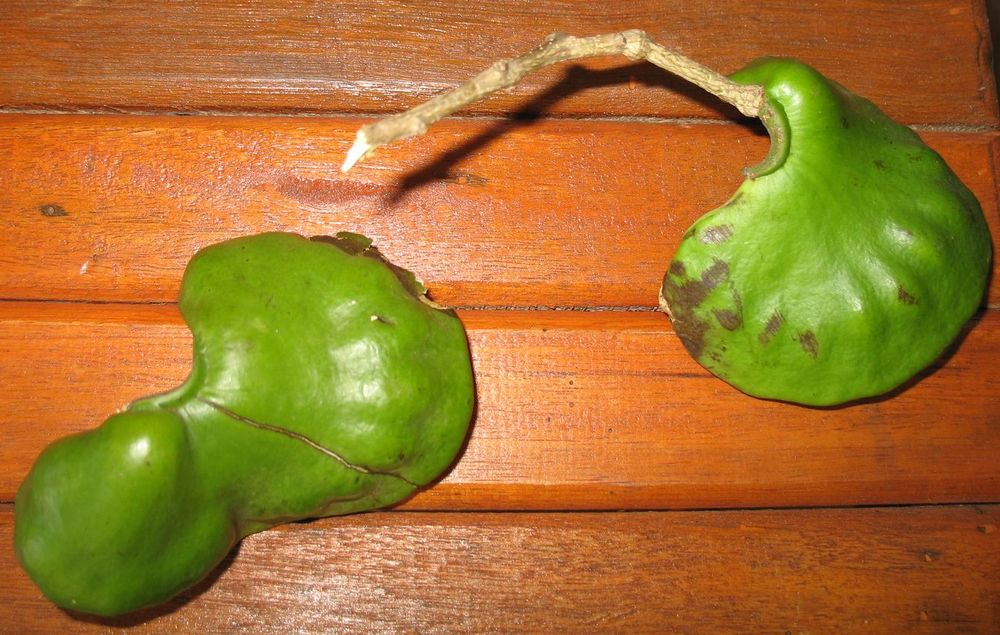
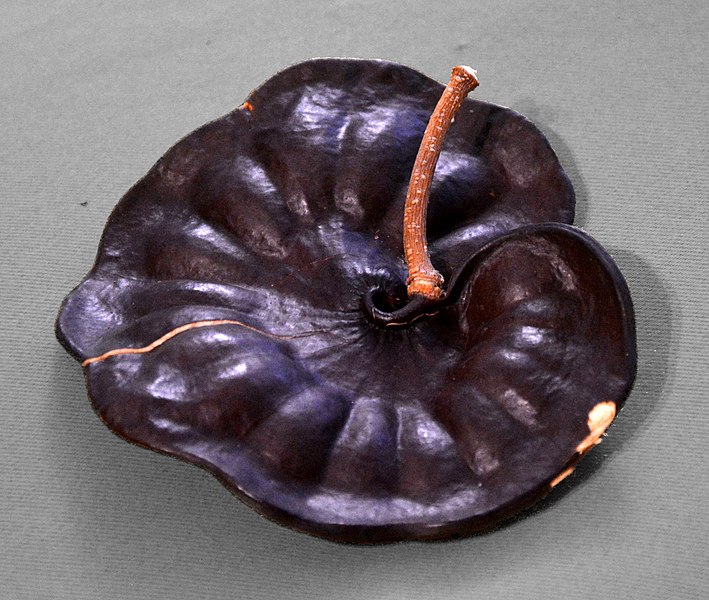
Today we are talking about a tree that seems familiar but is nevertheless foreign and rare in Laos. It seems familiar because it belongs to the large group of Leguminosae and is sometimes confused with the flamboyant; it is rare because it is an American tree that has traveled little, and yet we found two feet of it at the bottom of Wat Sok Palouang and another outside the enclosure wall of Wat Simuang, on the west side. This tree has no name in Lao and the people we interviewed either confessed their ignorance or called it tone fang (Flamboyant).
In most languages, scientific and vernacular, it is the shape of its pods that is decisive: they resemble a more or less large ear. Latin says cyclocarpum, that is to say “fruit in the shape of a cycle”; English evokes an elephant ear, Elephant Ear Tree, or devil’s ear, Devil’s Ear Tree; in Creole of the French West Indies it is called zorèy milat, “mulatto ear” in reference to the ethnic distinctions that have always been made in these islands. In Costa Rica, where its name comes from an Aztec language, the Guanacaste was declared a national tree in 1959.
Enterolobium cyclocarpum found from southern Brazil to the West Indies is a large tree that can reach 30 m with a powerful trunk and a few large main branches under a dome-shaped foliage, like a saman (sam sa). But the shape of this solitary tree depends much on its environment. Its bark is smooth and reddish, dotted with small characteristic bulges. Its leaves are alternate, bipinnate, from 15 to 40cm long, thin and light; they can, from far, be confused with those of the Flamboyant. Globular inflorescences, composed of about twenty small yellow odorous flowers, appear at the axis of the leaves. Then pods are progressively formed, first green, then brown at maturity, rigid like an old leather, rolled up in irregular circle from 8 to 15 cm, which can make think of ears. They are swollen by the seeds they contain, from 3 to 12, oblong, dark brown, bordered by a lighter line.
The wood of zorèy milat has many uses; light and resistant to water thanks to its resin, it was formerly used by the Amerindians to make their canoe; it is used today in the construction of houses and the manufacture of heavy and durable luxury furniture (“for a lifetime” says the popular saying). The fruit and bark of zorèy milat are rich in saponin and can be used as soap; the bark also contains tannins giving it an application in the leather industry. The hard seeds can be eaten boiled or roasted, but most importantly, they are used to make beautiful necklaces.
If you want to have a foot of this beautiful tree, you can now go and collect a few ripe pods at Wat Sok Palouang or Wat Simuang; you will have to break them by hand because they do not open by themselves. You will have to break them by hand because they do not open by themselves. You will then put them to soak in water for 7 to 8 hours to soften the tegument which is very hard. You can then plant them and they will germinate in 4 or 5 days. Finally, you should know that from the first year the tree reaches more than a meter and that afterwards it will need a lot of space to have a spread out port.
Nous parlons aujourd’hui d’un arbre qui semble familier mais qui pourtant est étranger et rare au Laos. Il semble familier car il appartient au grand groupe des Légumineuses et est parfois confondu avec le flamboyant; il est rare car c’est un arbre américain qui a peu voyagé, et pourtant nous en avons trouvé deux pieds au fond du Vat Sok Palouang et un autre à l’extérieur du mur d’enceinte du Vat Simuang, côté ouest. Cet arbre n’a pas de nom en lao et les personnes interrogées, soit avouaient leur ignorance, soit le nommaient tone fang (Flamboyant).
Dans la plupart des langues, scientifiques et vernaculaires, c’est la forme de ses gousses qui est déterminante: elles ressemblent en effet à une oreille plus ou moins grosse. Le latin dit cyclocarpum, c’est-à-dire « fruit en forme de cycle »; l’anglais évoque une oreille d’éléphant, Elephant Ear Tree, ou de diable, Devil’s Ear Tree; en créole des Antilles françaises on le nomme zorèy milat, «oreille de mulâtre » en référence aux distinctions ethniques qui ont toujours cours dans ces îles. Au Costa Rica, où son nom vient d’une langue aztèque, le Guanacaste a été déclaré arbre national en 1959.
Enterolobium cyclocarpum que l’on trouve du sud du Brésil jusqu’aux Antilles est un arbre de grande taille qui peut atteindre 30 m avec un tronc puissant et quelques grosses branches principales sous un feuillage étalé en dôme, à la façon des saman (sam sa). Cependant, la forme de cet arbre solitaire dépend beaucoup de son environnement. Son écorce est lisse et rougeâtre, parsemée de petits bourrelets caractéristiques. Ses feuilles sont alternes, bipennées, de 15 à 40cm de long, fines et légères; elles peuvent, de loin, être confondues avec celles du Flamboyant. Des inflorescences globuleuses, composées d’une vingtaine de petites fleurs odorantes jaunes pâles, apparaissent à l’axe des feuilles. Ensuite se forment progressivement des gousses, d’abord vertes, puis marrons à maturité, rigides comme un vieux cuir, enroulées en cercle irrégulier de 8 à 15 cm, qui peuvent faire penser à des oreilles. Elles sont renflées par les graines qu’elles contiennent, de 3 à 12, oblongues, marron foncé, bordées d’une ligne plus claire.
Le bois de zorèy milat a de nombreuses utilisations; léger et résistant à l’eau grâce à sa résine, il était utilisé autrefois par les Amérindiens pour faire leur canoë; il sert aujourd’hui dans la construction des maisons et la fabrication de meubles de luxe, lourds et durables (« pour toute une vie » dit le dicton populaire). Le fruit et l’écorce de zorèy milat sont riches en saponine et peuvent être employés comme savon; l’écorce contient également des tanins lui donnant une application dans l’industrie du cuir. Les graines dures peuvent être mangées bouillies ou grillées mais surtout, on en fait de très jolis colliers.
Si vous voulez avoir un pied de ce bel arbre, vous pouvez dès maintenant aller en ramasser quelques gousses mûres au Vat Sok Palouang ou au Vat Simuang; il faudra les casser à la main car elles ne s’ouvrent pas toutes seules. Vous les mettrez ensuite à tremper dans l’eau pendant 7 à 8 heures pour amollir le tégument qui est très dur. Vous pourrez ensuite les planter et elles germeront en 4 ou 5 jours. Sachez enfin que dès la première année l’arbre atteint plus d’un mètre et que par la suite il aura besoin de beaucoup d’espace pour avoir un port étalé.










Today we are talking about a tree that seems familiar but is nevertheless foreign and rare in Laos. It seems familiar because it belongs to the large group of Leguminosae and is sometimes confused with the flamboyant; it is rare because it is an American tree that has traveled little, and yet we found two feet of it at the bottom of Wat Sok Palouang and another outside the enclosure wall of Wat Simuang, on the west side. This tree has no name in Lao and the people we interviewed either confessed their ignorance or called it tone fang (Flamboyant).
In most languages, scientific and vernacular, it is the shape of its pods that is decisive: they resemble a more or less large ear. Latin says cyclocarpum, that is to say “fruit in the shape of a cycle”; English evokes an elephant ear, Elephant Ear Tree, or devil’s ear, Devil’s Ear Tree; in Creole of the French West Indies it is called zorèy milat, “mulatto ear” in reference to the ethnic distinctions that have always been made in these islands. In Costa Rica, where its name comes from an Aztec language, the Guanacaste was declared a national tree in 1959.
Enterolobium cyclocarpum found from southern Brazil to the West Indies is a large tree that can reach 30 m with a powerful trunk and a few large main branches under a dome-shaped foliage, like a saman (sam sa). But the shape of this solitary tree depends much on its environment. Its bark is smooth and reddish, dotted with small characteristic bulges. Its leaves are alternate, bipinnate, from 15 to 40cm long, thin and light; they can, from far, be confused with those of the Flamboyant. Globular inflorescences, composed of about twenty small yellow odorous flowers, appear at the axis of the leaves. Then pods are progressively formed, first green, then brown at maturity, rigid like an old leather, rolled up in irregular circle from 8 to 15 cm, which can make think of ears. They are swollen by the seeds they contain, from 3 to 12, oblong, dark brown, bordered by a lighter line.
The wood of zorèy milat has many uses; light and resistant to water thanks to its resin, it was formerly used by the Amerindians to make their canoe; it is used today in the construction of houses and the manufacture of heavy and durable luxury furniture (“for a lifetime” says the popular saying). The fruit and bark of zorèy milat are rich in saponin and can be used as soap; the bark also contains tannins giving it an application in the leather industry. The hard seeds can be eaten boiled or roasted, but most importantly, they are used to make beautiful necklaces.
If you want to have a foot of this beautiful tree, you can now go and collect a few ripe pods at Wat Sok Palouang or Wat Simuang; you will have to break them by hand because they do not open by themselves. You will have to break them by hand because they do not open by themselves. You will then put them to soak in water for 7 to 8 hours to soften the tegument which is very hard. You can then plant them and they will germinate in 4 or 5 days. Finally, you should know that from the first year the tree reaches more than a meter and that afterwards it will need a lot of space to have a spread out port.
Nous parlons aujourd’hui d’un arbre qui semble familier mais qui pourtant est étranger et rare au Laos. Il semble familier car il appartient au grand groupe des Légumineuses et est parfois confondu avec le flamboyant; il est rare car c’est un arbre américain qui a peu voyagé, et pourtant nous en avons trouvé deux pieds au fond du Vat Sok Palouang et un autre à l’extérieur du mur d’enceinte du Vat Simuang, côté ouest. Cet arbre n’a pas de nom en lao et les personnes interrogées, soit avouaient leur ignorance, soit le nommaient tone fang (Flamboyant).
Dans la plupart des langues, scientifiques et vernaculaires, c’est la forme de ses gousses qui est déterminante: elles ressemblent en effet à une oreille plus ou moins grosse. Le latin dit cyclocarpum, c’est-à-dire « fruit en forme de cycle »; l’anglais évoque une oreille d’éléphant, Elephant Ear Tree, ou de diable, Devil’s Ear Tree; en créole des Antilles françaises on le nomme zorèy milat, «oreille de mulâtre » en référence aux distinctions ethniques qui ont toujours cours dans ces îles. Au Costa Rica, où son nom vient d’une langue aztèque, le Guanacaste a été déclaré arbre national en 1959.
Enterolobium cyclocarpum que l’on trouve du sud du Brésil jusqu’aux Antilles est un arbre de grande taille qui peut atteindre 30 m avec un tronc puissant et quelques grosses branches principales sous un feuillage étalé en dôme, à la façon des saman (sam sa). Cependant, la forme de cet arbre solitaire dépend beaucoup de son environnement. Son écorce est lisse et rougeâtre, parsemée de petits bourrelets caractéristiques. Ses feuilles sont alternes, bipennées, de 15 à 40cm de long, fines et légères; elles peuvent, de loin, être confondues avec celles du Flamboyant. Des inflorescences globuleuses, composées d’une vingtaine de petites fleurs odorantes jaunes pâles, apparaissent à l’axe des feuilles. Ensuite se forment progressivement des gousses, d’abord vertes, puis marrons à maturité, rigides comme un vieux cuir, enroulées en cercle irrégulier de 8 à 15 cm, qui peuvent faire penser à des oreilles. Elles sont renflées par les graines qu’elles contiennent, de 3 à 12, oblongues, marron foncé, bordées d’une ligne plus claire.
Le bois de zorèy milat a de nombreuses utilisations; léger et résistant à l’eau grâce à sa résine, il était utilisé autrefois par les Amérindiens pour faire leur canoë; il sert aujourd’hui dans la construction des maisons et la fabrication de meubles de luxe, lourds et durables (« pour toute une vie » dit le dicton populaire). Le fruit et l’écorce de zorèy milat sont riches en saponine et peuvent être employés comme savon; l’écorce contient également des tanins lui donnant une application dans l’industrie du cuir. Les graines dures peuvent être mangées bouillies ou grillées mais surtout, on en fait de très jolis colliers.
Si vous voulez avoir un pied de ce bel arbre, vous pouvez dès maintenant aller en ramasser quelques gousses mûres au Vat Sok Palouang ou au Vat Simuang; il faudra les casser à la main car elles ne s’ouvrent pas toutes seules. Vous les mettrez ensuite à tremper dans l’eau pendant 7 à 8 heures pour amollir le tégument qui est très dur. Vous pourrez ensuite les planter et elles germeront en 4 ou 5 jours. Sachez enfin que dès la première année l’arbre atteint plus d’un mètre et que par la suite il aura besoin de beaucoup d’espace pour avoir un port étalé.


